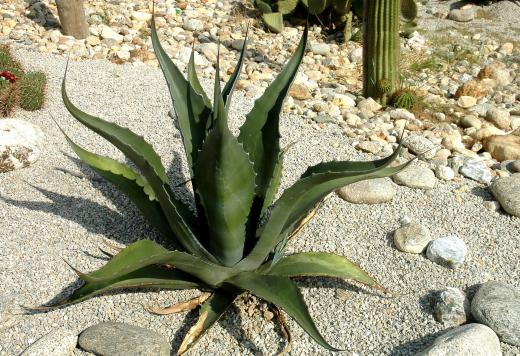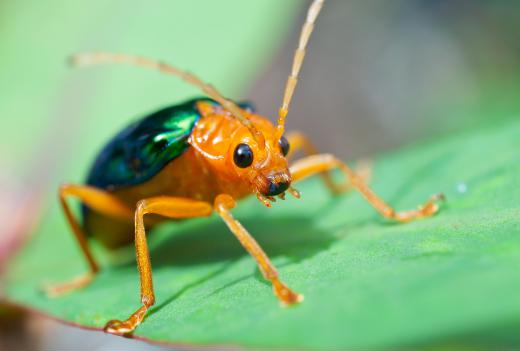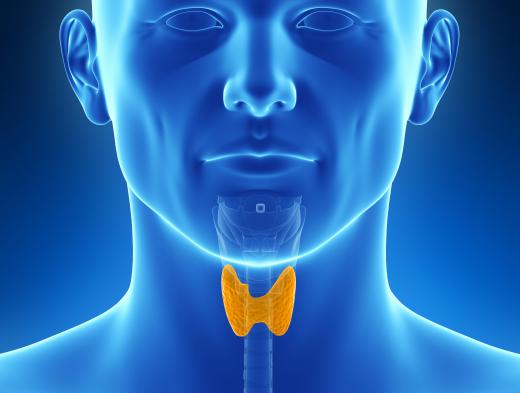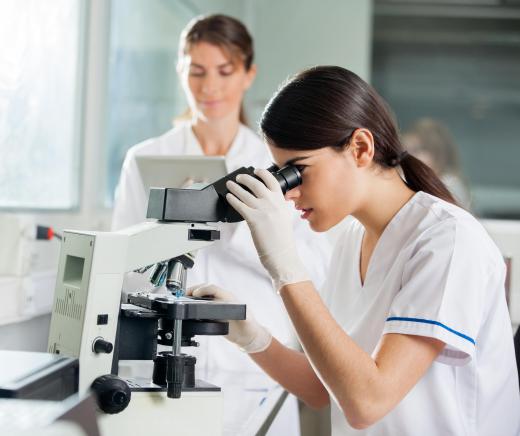What is a Peroxidase?
 Karyn Maier
Karyn Maier
A peroxidase is one of a number of enzymes that act as catalysts to allow a variety of biological processes to take place. Specifically, they promote the oxidation of various compounds using naturally occurring peroxides, especially hydrogen peroxide (H2O2), which are reduced, forming water. Peroxides are created as byproducts of various biochemical reactions within organisms, but can cause damage as they are oxidizing agents. Peroxidases break these compounds down in to harmless substances by adding hydrogen, obtained from another molecule — known as a donor molecule — in a reduction-oxidation (redox) reaction in which the peroxide is reduced to form water, and the other molecule is oxidized. There are a large number of these enzymes, and they are found in plants and animals, including humans.
Structure and Properties

Like all enzymes, peroxidases are very large, complex molecules with complicated shapes involving multiple folds. They come in a variety of types, some of which can use a wide variety of donor molecules and reduce a wide range of peroxides, and some of which are much more specific. Enzymes have an “active site,” which is the part of the molecule where the reaction takes place. This may be in an easily accessible part of the molecule, or it may be tucked away in a fold, where it can only be reached by a molecule of exactly the right shape. Horseradish peroxidase (HRP) is an example of an enzyme that can use a wide variety of donor molecules and peroxides.
Role in Biological Systems

A number of peroxidases are found in plants, where they may help minimize damage caused by stress factors or insect pests. When plants are subjected to stress — such as drought or high temperatures — or to attack by pests, this tends to result in the release of reactive oxygen species (ROS). These are forms of oxygen, or compounds of this element, including hydrogen peroxide, in which the oxygen is very reactive, and can damage or kill cells. It is thought that peroxidases remove ROS, helping prevent damage.

In humans, and other mammals, a group of these enzymes called glutathiones, which contain the element selenium, are found both within and outside cells. Some of these catalyze reactions involving H2O2, while others use peroxide compounds of lipids (fats and oils). Their main role seems to be to remove these potentially harmful oxidizing agents. Peroxidases in the saliva also enable redox reactions between H2O2 and chemicals called thiocyanates, producing compounds that can kill potentially harmful microorganisms. Thyroid peroxidase releases iodine from nutrients to form essential thyroid hormones.

One unusual use of these enzymes occurs in a group of insects known as bombardier beetles. They have a chamber containing a mixture of hydrogen peroxide and chemicals called hydroquinones. When threatened, they mix these with peroxidases, which catalyze a redox reaction in which a lot of heat is released, with the resulting liquid ejected explosively at 212°F (100°C). It is a very effective way of deterring predators.
Uses
The study of plant-based peroxidases, such as HRP derived from horseradish root, has furthered the fields of molecular biology and immunohistochemistry, also known as histochemistry. In the former, HRP is used to detect peroxidase antibodies that may indicate an autoimmune condition that causes thyroid problems. It is also used to measure serum or urine levels of glucose. As a diagnostic tool in pathology, HRP has the ability to target and bind to certain biomarkers found in cancerous cells and produce a stain reaction when introduced to biopsy samples. Aside from being readily available and inexpensive to obtain, HRP is considered particularly useful for such tests due to being highly stable and open to reacting with a variety of donor molecules.
History
Investigation into the nature of these enzymes was driven by experiments on the decomposition of hydrogen peroxide by the French baron and chemist, Louis Jacques Thénard in the mid-19th century. Having been the first to produce the compound in a laboratory, he later found that many animal and plant materials could convert it into water and oxygen, and that the same sample of material could do this many times over. This was curious, as if it was a simple chemical reaction between the peroxide and something in the organic material, it should stop once the active agent was used up. This led to the discovery of catalysts — substances that enable a chemical reaction without actually participating in it — and, specifically, peroxidases.
AS FEATURED ON:
AS FEATURED ON:














Discussion Comments
I really wish this was more specific about the structure and its activity.
@gamerdan -- As far as tests go, it's pretty accurate. In fact, most of the the people that receive positive results on a thyroid peroxidase test (somewhere between 70 -90%) do indeed have chronic thyroidosis, however there are a some auto-immune disorders that can cause a false positive as well. Lupus and rheumatoid arthritis are probably the most common culprits for this.
So how accurate is a perioxidase test, exactly? My cousin is going in for an HRP test because of her thyroid, and I'm just trying to learn as much about it as possible before she gets her results back. Does anybody have any information about this?
Post your comments